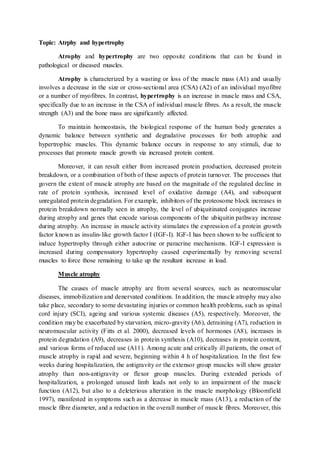
musclr atropy.docx
- 1. Topic: Atrphy and hypertrophy Atrophy and hypertrophy are two opposite conditions that can be found in pathological or diseased muscles. Atrophy is characterized by a wasting or loss of the muscle mass (A1) and usually involves a decrease in the size or cross-sectional area (CSA) (A2) of an individual myofibre or a number of myofibres. In contrast, hypertrophy is an increase in muscle mass and CSA, specifically due to an increase in the CSA of individual muscle fibres. As a result, the muscle strength (A3) and the bone mass are significantly affected. To maintain homeostasis, the biological response of the human body generates a dynamic balance between synthetic and degradative processes for both atrophic and hypertrophic muscles. This dynamic balance occurs in response to any stimuli, due to processes that promote muscle growth via increased protein content. Moreover, it can result either from increased protein production, decreased protein breakdown, or a combination of both of these aspects of protein turnover. The processes that govern the extent of muscle atrophy are based on the magnitude of the regulated decline in rate of protein synthesis, increased level of oxidative damage (A4), and subsequent unregulated protein degradation. For example, inhibitors of the proteosome block increases in protein breakdown normally seen in atrophy, the level of ubiquitinated conjugates increase during atrophy and genes that encode various components of the ubiquitin pathway increase during atrophy. An increase in muscle activity stimulates the expression of a protein growth factor known as insulin-like growth factor I (IGF-I). IGF-I has been shown to be sufficient to induce hypertrophy through either autocrine or paracrine mechanisms. IGF-I expression is increased during compensatory hypertrophy caused experimentally by removing several muscles to force those remaining to take up the resultant increase in load. Muscle atrophy The causes of muscle atrophy are from several sources, such as neuromuscular diseases, immobilization and denervated conditions. In addition, the muscle atrophy may also take place, secondary to some devastating injuries or common health problems, such as spinal cord injury (SCI), ageing and various systemic diseases (A5), respectively. Moreover, the condition may be exacerbated by starvation, micro-gravity (A6), detraining (A7), reduction in neuromuscular activity (Fitts et al. 2000), decreased levels of hormones (A8), increases in protein degradation (A9), decreases in protein synthesis (A10), decreases in protein content, and various forms of reduced use (A11). Among acute and critically ill patients, the onset of muscle atrophy is rapid and severe, beginning within 4 h of hospitalization. In the first few weeks during hospitalization, the antigravity or the extensor group muscles will show greater atrophy than non-antigravity or flexor group muscles. During extended periods of hospitalization, a prolonged unused limb leads not only to an impairment of the muscle function (A12), but also to a deleterious alteration in the muscle morphology (Bloomfield 1997), manifested in symptoms such as a decrease in muscle mass (A13), a reduction of the muscle fibre diameter, and a reduction in the overall number of muscle fibres. Moreover, this
- 2. condition may also have a negative affect on bone health by decreasing bone mineral density at the lumbar spine, femoral neck and calcaneus. Interestingly, the duration of immobility has been shown to be positively correlated with the degree of muscle atrophy (A14). The early signs of muscle atrophy found in these patients are accompanied by general weakness (A15) and fatigue (A16), especially in the lower limb (A17). In fact, these clinical signs may be caused either by the medication or pathological condition per se. Therefore, it is inappropriate to conclude the patient’s condition based only on muscle testing alone. Some other clinical assessments such as electrodiagnosis, computerized muscle strength analysis and biochemical analyses are essential for providing verification and further confirmation of the status of the muscles in question. The clinical assessments for disuse muscle atrophy can be performed at the bedside, accompanied with the strength assessment by observing muscle movement, muscle tone, muscle size and muscle strength. Muscle hypertrophy Hypertrophy of a muscle is a multidimensional process involving several factors such as growth factors (GFs), IGFs (A29), clenbuterol, anabolic steroids, hormones (A30), the immune system, and satellite cells (A31). For example, in a study investigating IGF-I peptide levels in human muscle following 10 weeks of strength training in old men and women (aged 72–98 years), it was shown that there was a c. 500% increase in the levels of IGF-I within the muscle fibres of these subjects after the training period, as determined using immunohistochemistry. This demonstrates that the peptide levels in older muscles may adapt over the longer-term to exercise training. Indeed, the results of longitudinal strength training studies have confirmed that the muscles of even very elderly people are able to exhibit a hypertrophy response to resistance exercise (A32). IGF-I is also thought to be involved in the activation of satellite cells, satellite cells are small mononucleate muscle stem cells located between the sarcolemma and basal lamina of muscle fibres. Recently, the link between satellite cell number and myofibre size has been demonstrated in both untrained and hypertrophied human muscle fibres. These cells, when activated, are believed to proliferate and differentiate into myoblasts, which then fuse with existing fibres, thus providing new nuclei to maintain the ratio of DNA to protein for fibres undergoing hypertrophy. The link between IGF-I, satellite cells, and hypertrophy has been shown in studies where localised infusion of IGF-I into the tibialis anterior muscle of adult rats resulted in an increased total muscle protein and DNA content. More recently, Bamman et al. (2001) reported a 62% increase in IGF-I mRNA concentration in human muscle 48 h after a single bout of eccentric resistance type exercise.
